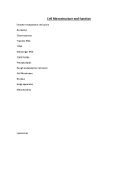Cell Structure Revision Notes
Structure of a typical plant cell:
- Contains cytoplasm and a nucleus. Rough and smooth ER found in the cytoplasm, along with Golgi. Mitochondria produce ATP
- Nucleus is surrounded by a double membrane
- Organelles in the cytoplasm are surrounded by one membrane
Plant cell wall:
- Cell wall gives strength and support- made up of insoluble cellulose
- In cellulose, the monomer units are beta glucose and held together by 1,4 bonds, where one monomer has to be turned around so the bonding can take place
- This linking of beta glucose molecules means that the hydroxyl groups stick out on both sides of the molecule
- This means hydrogen bonds can form between the partially positively charged hydrogen atoms of the hydroxyl groups and the negatively charged oxygen atoms in other areas of the glucose molecules
- This is known as cross linking and it holds neighbouring chains firmly together
- In the cell wall, cellulose molecules form microfibrils, which are laid down in layers held together by a matrix.
- Contains a middle lamella which is made of pectin which helps hold adjacent cells together
- Plasmodesmata are involved in cell to cell transport. Both cell walls are absent, lined with membrane and have a cytoplasm filled channel with ER extending through
- Pits are also involved in cell to cell transport. Their secondary cell wall is absent and they are lined with membrane.
Plant cell organelles:
Chloroplasts:
- Enable plants to produce their own food
- Large organelles- biconvex shape, 4-10mm long
- Double membranes are present
- Many internal membranes, some are arranged as stacks called grana
- Loop of DNA found in the stroma
Amyloplasts:
- Double membrane present
- Contains one type of starch called amylopectin
- Amylopectin sometimes shows concentric rings









